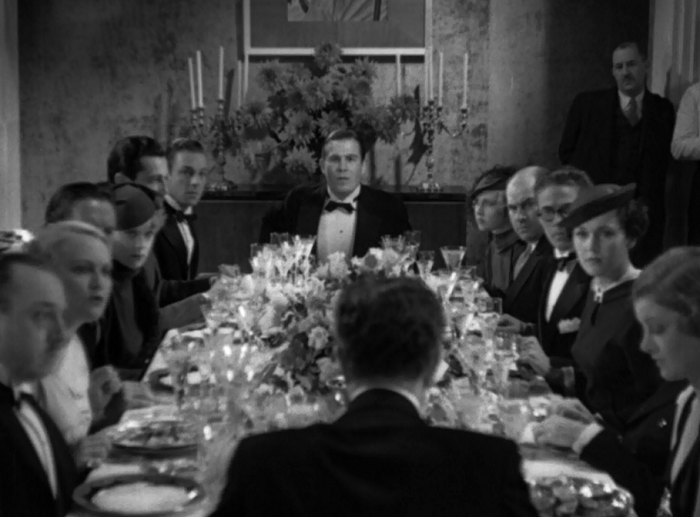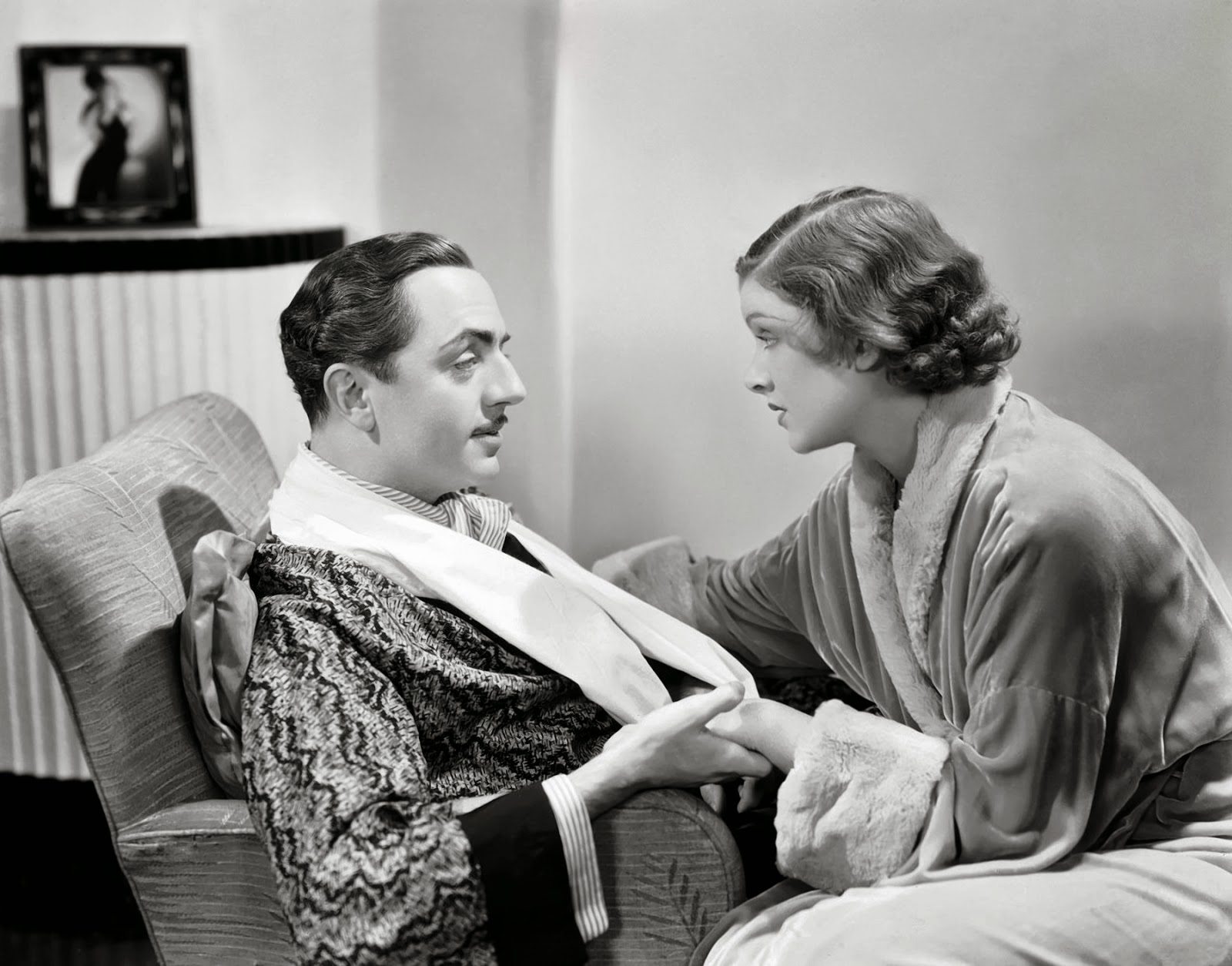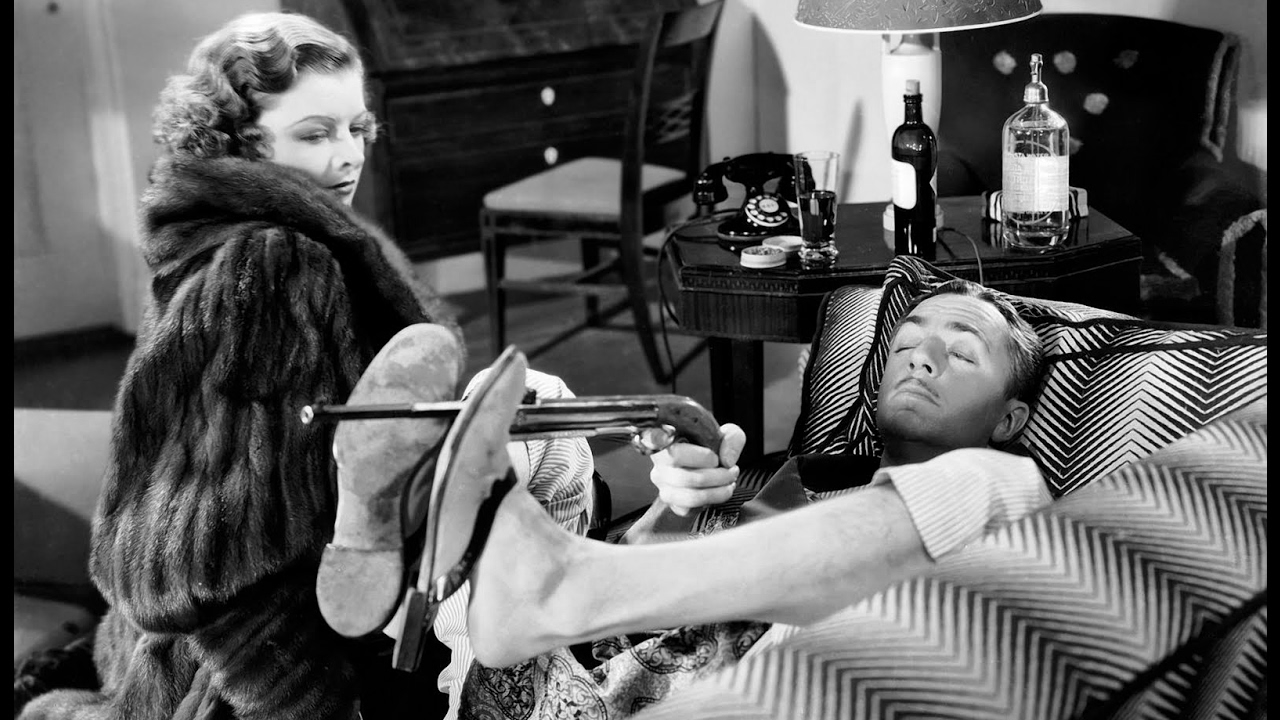Quick quiz: in 1934’s MGM classic The Thin Man, what is the key piece of evidence that leads Nick (William Powell) and Nora Charles (Myrna Loy) to convene the dinner party at which the killer of Claude Wynant (Edward Ellis), Julia Wolf (Natalie Moorhead), and the stool pigeon Nunheim (Harold Huber) is revealed?

If you answered, “Well, obviously it’s the leg shrapnel that Nick discovers in an x-ray of the body buried in Wynant’s workshop!” you probably have a better memory than most, or at least have seen the film more recently. The speed with which The Thin Man zooms past this erstwhile revelation is pretty impressive.
Too easy? Fine. How about: why did Wynant’s ex Mimi (Minna Gombell) remove his watch chain from the scene of Julia’s murder?
Actually, this isn’t even part of the quiz; I’m legitimately asking. I assume it’s because Mimi needed Wynant to be perceived as alive so that she can keep getting payoffs from his attorney MacCauley (Porter Hall), not realizing that the will MacCauley drew up for Wynant specified she’d only be cut off from the family fortune if she remarried, but because her husband Chris Jorgenson (Cesar Romero) turns out to be a bigamist who was never actually divorced from his previous wife, she’s still the rightful heir, leading Mimi to roll over on MacCauley, thereby removing suspicion from the embezzling bookkeeper Tanner (Cyril Thornton), who had been splitting his ill-gotten proceeds with Julia prior to her murder. And Nunheim just knew too much, and had a history of squealing. I think.
Luckily, none of this matters. (But wait … why wouldn’t Mimi at least then be charged as an accessory after the fact? Could she actually have been trying to shield her daughter Dorothy (Maureen O’Sullivan) from the knowledge of her father’s death, thereby keeping the gravy train rolling while also preserving some semblance of familial innocence? Ok, just let it go.)
In W.S. Van Dyke‘s brisk, bubbly Dashiell Hammett adaptation, the convoluted narrative is itself part of the joke. (And then that joke becomes the title!) The film — dashed off in 2 weeks of shooting, apparently, like a last nightcap before bed — became a surprise mega-hit at the height of the Depression, on the strength and charm of its leads rather than its occasional noir-ish elements. The audience is mostly placed in the middle of the commotion, like our bemused heroes, lost in wordplay and casual glamour. Ebert’s comparison of Nick and Nora to Fred Astaire and Ginger Rogers is entirely apt.
Just as no one would bring up Top Hat or Swing Time to celebrate the intricacies of their plotting (“The real hero here is Allan Scott,” said nobody ever), The Thin Man is rightfully remembered as a particularly appealing pas de deux, escapist spectacle at its best (and often silliest).
 Nick and Nora’s banter is inspired, but it’s all in the ease of the delivery, an obvious affection for each other that let the newly official Hays Code censors overlook gags that might otherwise have been shut down, particularly if they weren’t married. There’s a lot of lap-sitting, necking, and innuendo here — not to mention Asta The Dog covering his eyes in a reaction shot when our heroes actually get down to lovin’ off-camera — but it can be accepted in the larger depiction of a truly happy, if unconventional, union.
Nick and Nora’s banter is inspired, but it’s all in the ease of the delivery, an obvious affection for each other that let the newly official Hays Code censors overlook gags that might otherwise have been shut down, particularly if they weren’t married. There’s a lot of lap-sitting, necking, and innuendo here — not to mention Asta The Dog covering his eyes in a reaction shot when our heroes actually get down to lovin’ off-camera — but it can be accepted in the larger depiction of a truly happy, if unconventional, union.
At the same time, there’s some real darkness lurking in the corners of The Thin Man, both courtesy of master cinematographer James Wong Howe (particularly in the near-blackness of the workshop sequence) and on the more thematic level those images mirror. As Nora Fiore writes in an entertaining post:
Whether it meant to or not, The Thin Man betrays considerable anxiety about the fragility of family. From the bit-part drunk at Nick and Nora’s party, wailing “Ma!” long distance into the telephone, to the more central questions of the plot, less-than-ideal relationships prove to be the norm, rather than the exception… Dorothy’s speech about giving birth to a bunch of little murderers who will hopefully “kill each other and keep it in the family” may be the most genuinely creepy line of dialogue ever spoken at M-G-M. We witness Nunheim’s ugly domestic quarrel and ultimately find out that Jorgeson is a bigamist… Within this mess, Nick and Nora stand out as the Harlequin and Columbine whose magical union somehow holds the key to our continued hope for love.
That “magic,” though, is at the heart of The Thin Man‘s enduring appeal. Unlike the similarly witty, urbane anti-heroes of something like Trouble In Paradise, where the darkness is only held at bay by the famous “Lubitsch touch,” Nick and Nora convey a particular sort of innocence along with their insolence. What could ever happen to these people?
It’s all a lark — even when people get shot. (“I read you were shot 5 times in the tabloids.” “It’s not true! He didn’t come anywhere near my tabloids.”) Nick is only a detective these days by circumstance, whim, and Nora’s urging, anyway, and, even with three murders to account for, the mystery mostly gets in the way of the drinking. (“Is he working on a case?” “Yeah, a case of Scotch. Pitch in and help him.”)
The details trail away like bits of overheard conversation at a party. You just remember the movement, the swirl of it all, and two very funny people who seem to really like each other.
After a prologue set three months earlier, most of the movie takes place over the holiday season, including cocktail parties on Christmas Eve and Christmas Day, and the exposure of the killer at a dinner party sometime around New Years’ Eve. The movie is based on a novel by Dashiell Hammett, one of the fathers of noir, and it does technically provide clues, suspects and a solution to a series of murders, but in tone and intent it’s more like an all-dialogue version of an Astaire and Rogers musical, with elegant people in luxury hotel penthouses and no hint of the Depression anywhere in sight.

